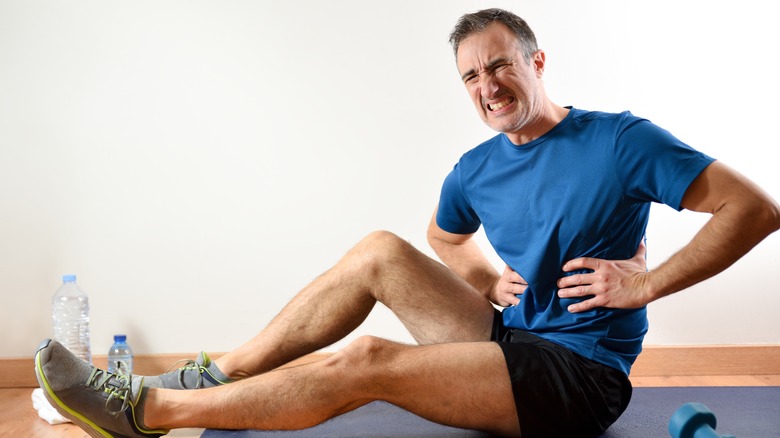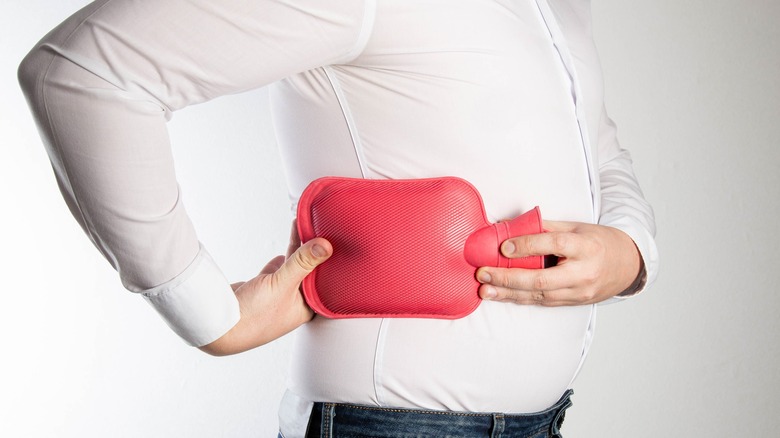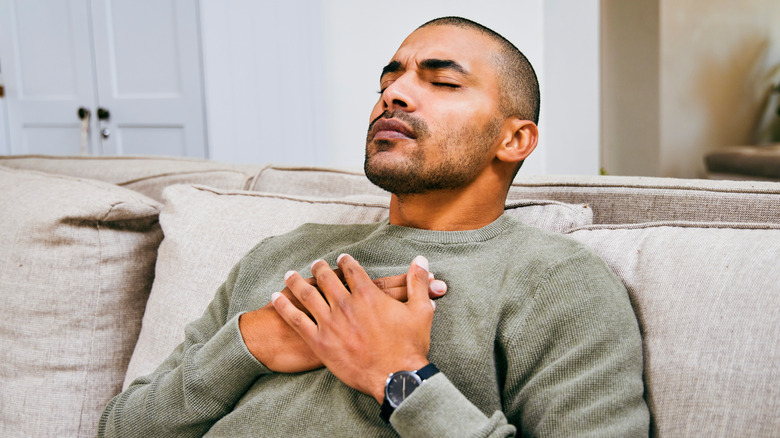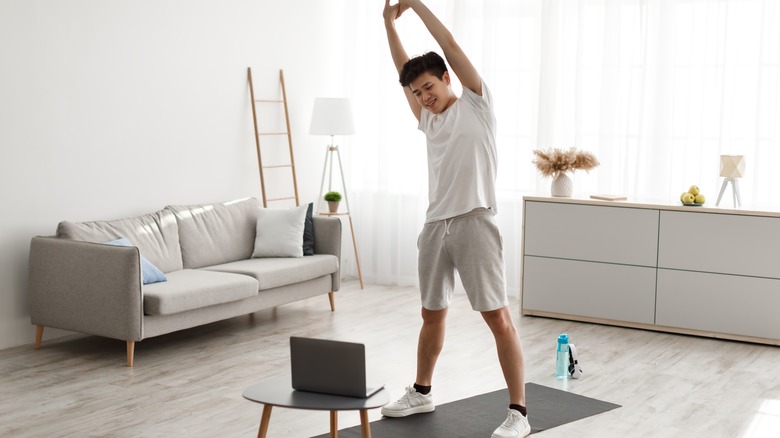What The Tightness And Pain In Your Ribs Could Mean
You finally get back into the gym and decide to work on your pull-ups. It might have been a while since you've done them, so you later feel some pain between your ribs. You could also feel tightness in your ribs if you've been reaching overhead for a long time, such as when painting the ceiling of your house. Pain in your ribs could also come from a sport where you're using a lot of repetitive force, such as baseball, rowing, or tennis. Even a yoga class might cause your ribs to feel pain if you're not used to the twisting (per Spine-Health).
The tightness in your ribs could mean a strain in your intercostal muscles, which are situated between your ribs. Straining these muscles can be painful for your chest and accounts for almost half of injuries involving your chest. No, there's no intercostal muscle machine at the gym, but you could injure these muscles while doing pull-ups or any repetitive or sustained movements that involve reaching or twisting. You could also strain your intercostal muscles if you cough or sneeze. This can be a problem because an intercostal muscle strain can restrict your ability to breathe. A series of sneezes, for instance, can be especially difficult (per Healthline).
Dealing with an intercostal strain
A strain in your intercostal muscles will be painful if you twist or try to take a deep breath. These muscles will also feel tight and sore if you touch them between your ribs. Sometimes a strain in your intercostal muscles can show up as pain in your shoulders or other places in your torso. Because there are many nerves and connective tissues that link the body together, you could feel referred pain from an intercostal muscle strain in your arm or shoulder.
If you suspect you have an intercostal muscle strain, see a doctor if the strain affects your daily activities. Your doctor will check your mobility and could order X-rays or other diagnostic imaging tests to rule out torn ligaments or broken bones (per Neuragenex). Mild intercostal strains can take two to three weeks to heal. More severe strains of your intercostal muscles can take months, and a ruptured intercostal muscle might need surgery (per Healthline).
Treating an intercostal strain
You can treat the pain by taking an over-the-counter pain reliever such as ibuprofen or naproxen. For the first few days after an injury, applying an ice pack or a frozen bag of peas to the area can help reduce some of the inflammation. Using heat (such as a heating pad) after a few days will warm the intercostal muscle so you can introduce movement. Soaking in Epsom salts can help relax you and your muscles (per Healthline).
Sleeping can be painful with an intercostal muscle strain. A heating pad can warm the muscles, so you can do some relaxing stretches before going to sleep. Breathing might be a little easier if you prop up your torso with some pillows. Side sleepers might find it painful if the strain is on their preferred side, so opt for the unaffected side and place a pillow between your knees to protect you from twisting. Back sleepers might find it more comfortable to hug a body pillow (per CityMD).
Don't overlook respiratory issues
Because breathing is more difficult when you injure your intercostal muscles, smoking will worsen your issues with respiration. If possible, stop smoking and avoid environments where you might encounter second-hand smoke. While compression is usually advised for some sprains and strains, that's not the case with your intercostal muscles because it makes it harder to breathe (per Spine-Health).
When you've strained your intercostal muscles, your breathing can become shallow. Shallow breathing can lead to complications such as pneumonia or other infections. While you're still recuperating from an intercostal muscle strain, you'll need to work on deepening your breath and expanding your lungs for a few minutes every hour. Deep breathing exercises where you hold your breath for 10 seconds will prevent respiratory complications (per Healthline).
Even if you start feeling better after a few days, it's not such a great idea to return to activity. You run the risk of re-injuring yourself because these muscles are still weak (per Spine-Health).
Breath practices to open your lungs
Once some of your pain has subsided, breathing practices can tone your intercostal muscles and your diaphragm. You can begin stretching your intercostals while also breathing in this intercostal stretching breath. Stand tall with your arms reaching overhead. On a deep inhale, stretch your arms as high as you can, and during the exhale, bend slightly to your right. Be sure this movement isn't painful if you're still recovering from an intercostal injury. On the next inhale, reach overhead again, then reach towards the left on the exhale. This will help bring back deep breathing into your lungs while also stretching your side body.
This next breath practice requires some blocks, but a pillow will also work. If you have blocks, lay one lengthwise behind your shoulder blades at its shortest height and the other at the medium height behind your head. If you have a pillow, prop your shoulder blades on the pillow and allow your arms to rest outstretched like a T with your palms facing up. On your inhale, feel the diaphragm push out your belly, then allow your lungs to expand and your chest to rise. Lead the exhale from the diaphragm, allowing the chest to fall last (per Power Breathe).
Stretches to help recover
A few yoga poses can help open up your chest area as you work your way back to recovering from an intercostal muscle strain. Cobra pose will help stretch the muscles of your front body and strengthen your back body. Begin on the floor on your stomach with your elbows bent and your hands facing down below your armpits. Adjust your hands so your elbows are pointing towards your outstretched legs. Using your legs and hips to ground you, slowly draw your chest off the floor using your core and back muscles. Your arms can help push you off the ground to give you a deeper stretch. Hold for up to 30 seconds, then release.
Extended puppy pose looks like child's pose with your hips in the air. Starting on all fours, walk your hands away from your knees as far as you can reach while keeping your hips directly over your knees. While pressing down with your hands to support you, drop your shoulders and chest to the floor. You can extend your arms further forward to get a deeper stretch in your shoulders. Take a few deep breaths into your chest, holding for up to a minute (per Stretch).






